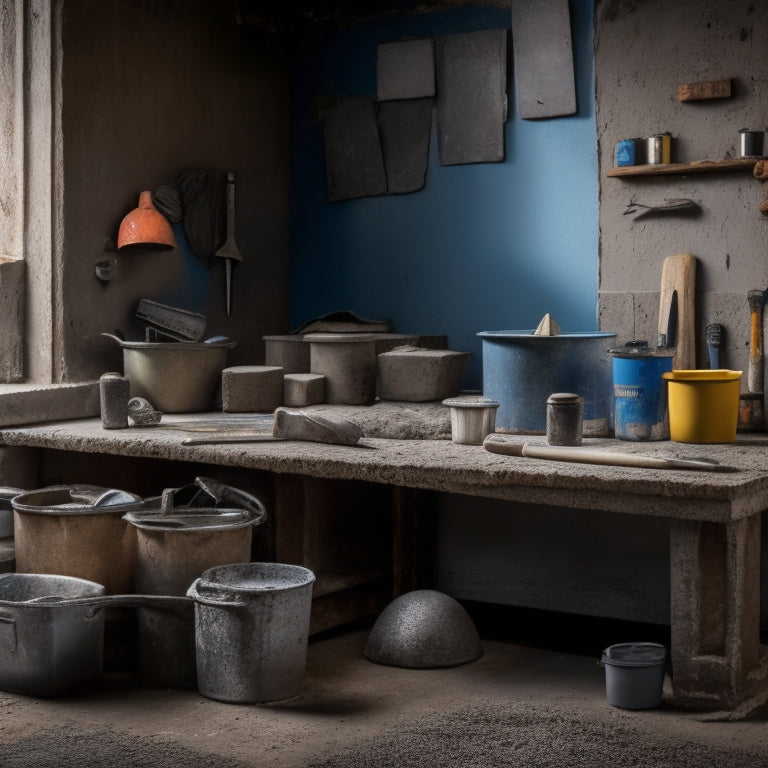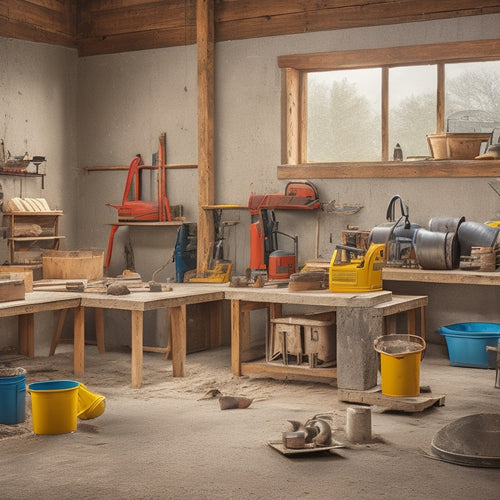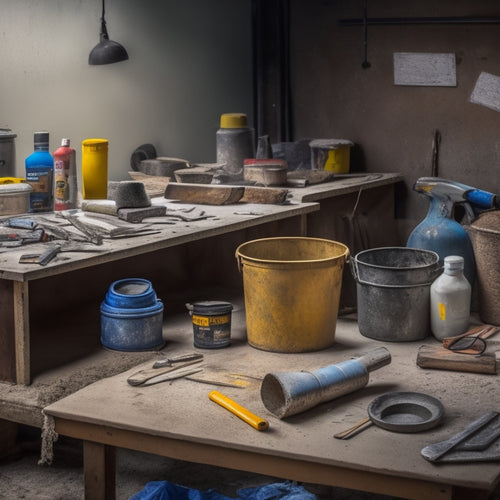
Top Tools for Beginners in Concrete Masonry Coating
Share
You're about to begin a concrete masonry coating project, and having the right tools is essential. Start with essential sealing sprayers that provide uniform application, considering pressure, flow rate, and nozzle size. Cinder block sealing tools, high-quality concrete coating brushes, and sealant application gun options are also must-haves. Don't forget safety equipment like respirators, safety glasses, and chemical-resistant gloves. For surface preparation, use wire brushes, pressure washers, and mixing buckets for sealant blends. Finally, consider adjustable roller extension poles for application efficiency. With these tools in your arsenal, you'll be well on your way to achieving professional-grade results – and there's more to explore to perfect your technique.
Key Takeaways
• Essential tools for application include sealing sprayers, cinder block sealing tools, concrete coating brushes, and sealant application gun options.
• Safety equipment like respirators, safety glasses, chemical-resistant gloves, and long clothing are must-haves for minimizing risks during coating applications.
• Proper surface preparation and cleaning tools, such as wire brushes, pressure washers, and mixing buckets, ensure accurate measurements and high-quality outcomes.
• Adjustable roller extension poles and length options enhance control, adaptability, and precision, leading to smooth finishes and reduced errors.
• Cost-effective tools that cater to various applications can simplify storage, reduce purchases, and achieve cost savings for beginners in concrete masonry coating.
Essential Sealing Sprayers for Beginners
Your sealing sprayer selection is critical to achieving a uniform, professional-grade concrete masonry coating application. As a beginner, it's vital to choose a sprayer that suits your needs and skill level.
When selecting a sealing sprayer, consider factors such as pressure, flow rate, and nozzle size. A high-pressure sprayer with a low flow rate is ideal for delicate surfaces, while a low-pressure sprayer with a high flow rate is better suited for large, rough surfaces.
To guarantee peak performance, follow these sprayer maintenance tips: regularly clean the nozzle and tip to prevent clogging, and lubricate the pump and seals to prevent wear.
Additionally, practice beginner spray techniques such as holding the sprayer at a consistent distance and moving in steady, overlapping strokes to achieve an even coating. Avoid applying too much pressure, which can cause uneven distribution and wastage.
Best Cinder Block Sealing Tools
When you're working with cinder block walls, you'll need the right tools to guarantee a professional-grade seal.
You'll want to focus on sealing those walls effectively and applying block coating evenly to achieve a durable, long-lasting finish.
To get started, let's explore the best cinder block sealing tools that'll help you master these essential steps.
Sealing Cinder Block Walls
Sealing cinder block walls requires a thorough application of a suitable sealant using the right tools to guarantee a durable, long-lasting barrier against moisture and the elements. As a beginner, you'll want to make sure that your cinder block walls are properly sealed to prevent water damage and maintain their structural integrity. This is especially important for exterior walls, which are constantly exposed to rain, snow, and other forms of moisture.
When it comes to cinder block maintenance, sealing is a vital step in preventing water from seeping into the walls and causing damage. By applying a suitable sealant, you'll be able to control moisture and prevent it from penetrating the walls.
This will help to prevent cracks, crumbling, and other forms of damage that can occur when water enters the walls. With the right tools and techniques, you'll be able to achieve a professional-looking finish that will last for years to come.
Applying Block Coating Evenly
To achieve a uniform, even coat on your cinder block walls, you'll need to invest in the right tools and master a few key techniques. One essential step is block surface preparation, which involves cleaning the surface to guarantee a strong bond between the block and the coating. Next, you'll need to choose the right coating application techniques, such as rolling, brushing, or spraying.
Here's a breakdown of the tools and techniques you'll need for a successful coating application:
| Tool/Technique | Purpose | Recommended Use |
|---|---|---|
| High-pressure washer | Clean the block surface | Before applying coating |
| Roller extension pole | Reach high areas and coat large surfaces | For large, flat areas |
| Brush | Coat corners, edges, and small areas | For detailed work |
| Sprayer | Apply coating quickly and evenly | For large, flat areas |
| Ladder or scaffolding | Access high areas | For coating above 6 feet |
Top Concrete Coating Brushes
You'll need a high-quality brush that can withstand the rigors of coating concrete, and these top picks deliver exceptional results.
When it comes to brush types, you'll want to evaluate the specific coating techniques you'll be using. For instance, natural bristle brushes are ideal for applying thick, textured coatings, while synthetic brushes are better suited for smooth, thin coatings.
For large, flat surfaces, a roller brush is often the best choice. These brushes feature extended handles and large, absorbent heads that can cover a lot of ground quickly.
On the other hand, angle-cut brushes are perfect for getting into tight spaces and corners. Their unique design allows for precise control and maneuverability.
Other top picks include wire brushes, which are great for rough, porous surfaces, and foam brushes, which are ideal for smooth, non-porous surfaces.
No matter which brush you choose, make sure it's high-quality and designed specifically for concrete masonry coating. With the right brush in hand, you'll be able to achieve professional-looking results with ease.
Must-Have Safety Equipment List
Before applying concrete masonry coatings, equip yourself with essential safety gear to minimize risks and guarantee a safe working environment.
As a beginner, it's vital to prioritize hazard awareness and invest in the right protective equipment. Start with a reliable respirator or dust mask to shield yourself from inhaling harmful particles and fumes.
Safety glasses or goggles will protect your eyes from debris and chemical splashes. A pair of durable, chemical-resistant gloves will prevent skin irritation and injuries.
Don't forget to wear long-sleeved shirts, long pants, and closed-toe shoes to cover your skin. A hard hat can also be necessary, depending on the job site's specific requirements.
Additionally, confirm you have a first-aid kit on hand in case of accidents.
Preferred Roller Extension Poles
When selecting a roller extension pole, you'll want to take into account the material it's made of, as it directly impacts the pole's durability and weight.
You'll also appreciate the convenience of adjustable length options, which allow you to tailor the pole's length to your specific coating task.
Pole Material Matters
Concrete masonry coating projects often demand a sturdy and reliable roller extension pole, making the choice of pole material a crucial factor in achieving a smooth, even finish.
You'll want a pole that can withstand the weight of the roller and coating material, as well as the physical demands of the job. When selecting a pole, consider the material's strength-to-weight ratio. A lightweight pole may be easier to handle, but it may not provide the necessary stability for longer pole lengths. On the other hand, a heavier pole may be more durable, but it can be cumbersome to maneuver.
You should also consider the pole length and how it will impact your workflow. A longer pole allows you to reach higher areas without the need for ladders, but it may be more difficult to control. Conversely, a shorter pole is more manageable, but it may require more frequent repositioning.
Ultimately, you need a pole that strikes a balance between pole weight and pole length. By choosing the right material, you can guarantee a smooth, even finish and a successful concrete masonry coating project.
Adjustable Length Options
You'll find that adjustable length options in roller extension poles offer the best of both worlds, allowing you to adapt to changing job demands while maintaining ideal control and maneuverability. This feature is particularly valuable in concrete masonry coating, where varying substrate heights and angles require flexibility in your tools.
With adjustable lengths, you can tackle a wide range of versatile applications, from coating small, intricate areas to covering large, expansive surfaces.
Here are some benefits you can expect from adjustable length options:
-
Effortless adjustments: Quick and easy length adjustments enable you to adapt to changing job requirements without wasting time or energy.
-
Increased precision: Adjustable lengths allow for more precise control over the roller, reducing the risk of errors and improving overall coating quality.
-
Enhanced safety: By adjusting the pole length to suit the task, you can maintain a comfortable working position, reducing fatigue and the risk of accidents.
- Cost-effective: With adjustable length options, you can tackle a variety of tasks with a single tool, eliminating the need for multiple specialized poles.
Sealant Application Gun Options
With a range of sealant application gun options available, selecting the right one for your concrete masonry coating project depends on the specific requirements of your job.
You'll need to take into account the type of sealant you're working with, as well as the application technique you'll be using. For example, if you're working with a high-viscosity sealant, you'll want a gun that can handle the thicker consistency.
When it comes to application techniques, you'll need to reflect on the surface you're coating and the level of precision required. Are you working on a large, flat area or a smaller, more intricate space? Do you need to apply a bead of sealant to a specific width or pattern? Different guns are better suited to different techniques, so it's crucial to choose the right one for your project.
Some sealant application guns are designed for high-volume use, while others are better suited to smaller, more precise applications.
You'll also want to take into account the level of pressure required to dispense the sealant, as well as any additional features, such as adjustable flow control or ergonomic design.
Cleaning Tools for Cinder Blocks
After applying sealant to your cinder blocks, turning your attention to cleaning tools is the next logical step to guarantee a successful concrete masonry coating project.
Cleaning is an essential part of cinder block maintenance, as it removes dirt, grime, and other substances that can affect the sealant's adhesion and performance.
You'll need the right cleaning tools to get the job done efficiently and effectively.
Here are four essential cleaning tools you should consider:
-
Wire brushes: Stiff-bristled wire brushes are perfect for scrubbing away heavy dirt and grime from cinder block surfaces.
-
Pressure washers: Pressure washers are ideal for blasting away dirt and debris from large areas of cinder block.
-
Broom or scrub brush: Soft-bristled brooms or scrub brushes are great for sweeping away loose dirt and dust from cinder block surfaces.
- Detergent and water: A mild detergent and water solution can be used to clean cinder blocks without damaging the surface or sealant.
Mixing Buckets for Sealant Blends
Accurate measurements and thorough mixing are critical when blending sealants, and a dedicated mixing bucket is vital for achieving consistent results.
You'll want a bucket that's specifically designed for mixing, with markings for accurate measurement and a sturdy construction that can withstand the rigors of repeated use.
When selecting a mixing bucket, consider the size of your projects and the amount of sealant you'll need to mix. Bucket sizes range from 1-5 gallons, so choose one that aligns with your typical project requirements. A larger bucket may be necessary for larger projects, but it's also important to avoid over-mixing, which can lead to inconsistent results.
To guarantee effective mixing, it's crucial to master various mixing techniques, such as the 'fold and scrape' method or the 'stir and sweep' technique. Regardless of the method you choose, a dedicated mixing bucket will help you achieve the consistent, high-quality results you need.
Frequently Asked Questions
Can I Use a Regular Paintbrush for Concrete Masonry Coating?
You're wondering if a regular paintbrush will cut it for concrete masonry coating. Here's the deal: it's not the best choice.
Regular paintbrushes are designed for smooth surfaces, not rough concrete. You'll struggle with even application and risk brush damage.
Instead, opt for a sturdy, nylon-bristled brush or a foam brush specifically designed for concrete masonry coating.
These tools will help you master the right application techniques for a smooth, even finish.
Do I Need to Seal New Cinder Blocks Before Applying a Coat?
'Measure twice, cut once' is a mantra that applies to cinder block preparation.
When it comes to sealing new cinder blocks before applying a coat, the answer is yes, you should. Unsealed cinder blocks can absorb moisture, causing the coating to fail.
You'll need to choose a suitable sealing method, such as applying a silane or siloxane-based sealer, to guarantee a strong bond between the block and coating.
Proper preparation is key to a successful concrete masonry coating project.
Is It Necessary to Wear Gloves When Applying Concrete Sealant?
When applying concrete sealant, you'll want to protect your skin from potential harm.
It's necessary to wear gloves to prevent skin irritation and absorption of toxic chemicals found in some sealants.
Opt for gloves made from materials like nitrile, neoprene, or PVC, which provide a barrier against sealant toxicity.
Make certain a snug fit and change them frequently to maintain protection.
Don't risk your health – wear gloves to safeguard your skin during the application process.
Can I Apply Concrete Sealant in Direct Sunlight or High Winds?
When applying concrete sealant, you'll want to avoid direct sunlight and high winds, as they can negatively impact the sealant's performance.
Instead, choose application conditions with moderate temperatures and minimal airflow to guarantee a smooth, even finish.
Proper surface preparation is also essential; make sure the concrete is clean, dry, and free of debris.
How Long Does It Take for Concrete Sealant to Fully Dry and Cure?
You'd wait an eternity for your concrete sealant to dry and cure if you didn't follow the instructions! But don't worry, it's not that long.
The drying time typically ranges from 30 minutes to an hour, depending on the type of sealant and environmental conditions.
The curing process, however, takes longer - usually 24 hours to reach full strength.
Make sure to follow the manufacturer's guidelines for ideal results.
Conclusion
You've got the tools, now it's time to build.
With these essentials in your arsenal, you're ready to tackle any concrete masonry coating project that comes your way.
Remember, a strong foundation is key, and with the right tools, you'll be laying the groundwork for success.
Your projects will be the brick-and-mortar backbone of the industry, standing tall and proud like a towering skyscraper.
Related Posts
-

What Tools to Rent for a Concrete Home Reno
When tackling a concrete home renovation, you'll need to rent a variety of specialized tools to get the job done. For...
-

3 Best Tools to Buy for Concrete Repair Online
When buying tools for concrete repair online, you'll want to research multiple retailer options to find the best prod...
-

7 Must-Have Tools for Concrete Repair Organization
To effectively organize your concrete repair projects, you'll need a thorough toolkit that includes a well-planned st...


